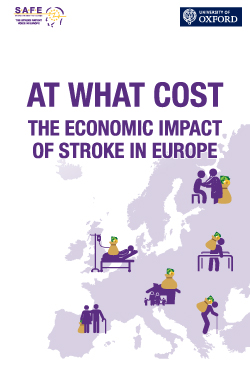Brussels, 9 November 2020 – New research published today shows future costs of stroke care in Europe could increase to €86 billion in 2040 if we fail to invest in stroke prevention, treatments and rehabilitation.
The study was commissioned by SAFE and undertaken by the heath economics team at the University of Oxford, pre COVID-19.
At What Cost – the Economic Impact of Stroke in Europe [add in link] adds to the existing evidence that shows stroke care is woefully underfunded and needs urgent investment.
Lead researcher, Dr Ramon Luengo-Fernandez says: “The research was completed before COVID-19. Since the beginning of the pandemic, services have been diverted away from non-infectious conditions, including stroke care, therefore we feel that the projected costs in our report are likely to be even higher.”
The study included all stroke-related costs that occurred in the EU countries plus the UK, Israel, Norway, Iceland and Switzerland in 2017.
Report findings show for the first time the cost of stroke along the whole stroke care pathway, including not only direct healthcare costs but also the costs of informal care and productivity losses due to disability or death from stroke. The study provides scientific projections related to stroke costs for the next 20 years.
In addition, the report looks at three interventions which are in the latest stroke guidelines – the treatment of atrial fibrillation to prevent stroke, mechanical thrombectomy (the clot retrieval from the blood vessel in the brain) in the acute phase of stroke and community-based rehabilitation after stroke. The research shows that no matter at which point in the stroke pathway you intervene – prevention, treatment, long-term care – there’s likely big gains to be had in terms of patient outcomes and cost savings.
In 2017, nearly 1.5 million people suffered a stroke, nine million Europeans lived with a stroke, and more than 430,000 people died due to a stroke in the 32 countries under this study. The total cost of stroke in 2017 was a €60 billion.
The number of new strokes and the number of people living with stroke is set to rise due to ageing population in Europe, as age is the biggest, non-modifiable risk factor for stroke. The costs of stroke are projected to increase by 44% between 2017 and 2040, with some countries seeing rises in stroke-related costs of nearly 100%.
SAFE’S Director General, Arlene Wilkie adds, “Health systems across Europe have been left crushed and broken by COVID-19. Stroke is preventable and it is crucial that we invest in care and support that can respond to the current and future needs of stroke survivors.
This research offers solutions to help reduce the burden of stroke and future proof healthcare services at the time when COVID-19 has amplified the problem and exposed already overstretched and failing healthcare systems. SAFE calls on the EU and national governments to make stroke care a priority and ensure it is fit for the future.”





